Calosoma (Callisthenes) elegans (Kirsh, 1859)
C. elegans, C. panderi and C. kushakevitchi are a similar enough group of species, characterized by the raised border of the pronotum, and by the rather short and wide elytra with a relatively broad margin.
The cluster represented by C. elegans contains a number of populations that all have a rough lateral margin of the elytra, a massive head and a transverse pronotum with well developed posterior lobes. The model of the elytral sculpture is triploid, except in the individuals of two groups of populations where it tends to become of pentaploid type by doubling the tertiary intervals. As for the other characteristics of the sculpture, they are extremely variable: either all the intervals are raised with deep transversal wrinkles, the primary ones being interrupted by more or less large dimples, or all the intervals are very little raised or completely flattened; the striae are preserved as fine rows of dots or are more less completely obliterated, in the last case the primary dimples then usually being more conspicuous. Coloring also is very variable: the upper side happens to be black monochrome or black with reddish or coppery or greenish reflection, or, in other cases, the edges of the pronotum and of the elytra or the entire upper side can be coppery or brass-colored or green.
Following this great variability of size, sculpture and color, many taxa have been described, which already Breuning (1928: 64) suspected might be living together in the same locality. Actually while few populations living in clearly circumscribed areas are morphologically differentiated enought, many others living in intermediate areas have less defined or mixed characteristics. According to Obidov (2002), all these minute morphological differences would justify the distinction of most of these populations at the subspecies level.
For the purposes of this discussion, we prefer to gather these populations in a few groups (subspecies) on the basis of the of the prevalent characteristics of the elytral sculpture. As a general rule, in the western populations all the intervals are raised, strongly scaly and clearly aligned, while, in the eastern ones the intervals become progressively flat, and the striae are replaced by fine rows of dots. As previously noted by Obidov (1997: 170), these populations follow one another from west to east, progressively modifying their characteristics, from southern Kazakhstan to Xinjiang in China (elegans s. str., manderstjernae, semenovi and rostislavi), while in the south there is a relatively isolated population in central Kyrgyzstan (karagaicum).
Calosoma (Callisthenes) elegans elegans (Kirsh, 1859)
Callisthenes elegans Kirsh, 1859: 197 (described from: Songorei)
Callisthenes declivis Dohrn, 1884: 405 (described from: Turkestan); lectotype ♂, paralectotypes 1♂, 1♀ (designed by Kabak, 2004) in Muzeum i Instytut Zoologii. Polskiej Akademii Nauk, Warszawa (synonymy established by Kabak, 2016: 798)
Calosoma (Callisthenes) panderi ssp. elegans Breuning, 1928: 63 (partim)
Callisthenes karelini elegans elegans Lapouge, 1932: 376
Callisthenes elegans elegans Jeannel, 1940: 194
Callisthenes elegans saryarkensis Kabak, 1992:74 (type locality: Koksengir mount, Karaganda distr.); holotype ♂ in Zoological Museum of the Russian Academy of Sciences, Saint Petersburg
Callisthenes elegans kolshengelicus Obydov, 1997: 167 (type locality: Koshengel); holotype ♂ ex coll. Obydov
Callisthenes elegans valentinae Obydov, 1997: 167 (type locality: env. Kapchagai, left bank of the Ily river); holotype ♂ ex coll. Obydov
Callisthenes elegans purpureus Obydov, 2002: 37 (type locality: Mezhdurechensk left bank of the Kaskelen river); holotype ♂ ex coll. Obydov
Calosoma (Callisthenes) elegans Bruschi, 2013: 254
Calosoma (Callisthenes) elegans Kabak, 2016: 796
Length 18-32 mm. The various populations collected in C. elegans elegans are characterized by the conspicuously developed posterior lobes of the pronotum and by the long-oval elytra, whose upper surface is a just a little arched, with elytral sculpture of triploid type and with elevated, incised and imbricate, intervals. The color of the upper part of the body is more or less dark, always with copper reflections.
The bulk of these populations, further characterized by larger body (24-32 mm.), and by absent or barely detectable foveae on the primary intervals, is located in southern Kazakhstan from the arid areas north of Lake Baikal to Kyrgyzstan (Bishkek).
Kabak (2016), having examined the specimens on which Dohrn (1884: 405) based his description of C. declivis, recognized them as belonging to the nominotypical population of C. elegans.
As regard to the various subspecies recognizes by Obidov, north West of the lake Baikal in the Karagandy region, near Koksengir mountain, we find one relatively isolated population that Kabak (1992: 74) has named Callisthenes elegans saryarkensis, and that is composed by dark colored individuals, having grainy intervals of the elytra in which the slightly more raised primary intervals stand out. Further south, near the village of Kolshengel, Obydov (1997: 167) described with the name Callisthenes elegans kolshengelicus a population that is barely distinguishable from the typical one due to the reduced body size (18 to 23.5 mm), and the brighter color of the upper body.
Two more populations, namely Callisthenes elegans valentinae and Callisthenes elegans purpureus, living in the areas of contact of C. elegans elegans with other subspecies, can be interesting from the point of view of the evolutionary dynamics of the species. They are found towards east, near the distribution area of C elegans semenovi and C. elegans manderstjiernae. Both have less elongated body shape and a slightly less raised elytral sculpture, as it occurs in eastern subspecies, but these characteristics are too tenuous and not always constant, to justify further taxonomic distinctions.
Examined specimens and literature’s data
Kazakhstan. Almaty reg: Kolshengel (Obydov, 1997: 167, sub elegans kolshengelicus; SB, TL), Kapchagay env. (SB) (Obydov, 2002: 30; sub elegans valentinae), Mezhdurechenskoye (Mezhdurechensk) (Obydov, 2002: 37, sub elegans purpureus); Karagandy reg: Shalgiya (near Karazhal) (SB), 10km SW from Mynaray village (SB), Koksengir mount (Obydov, 2002: 28; sub elegans saryarkensis), 40km S. Zhana-Arka (Obydov, 2002: 28; sub elegans saryarkensis); Žambyl reg: Korday 1400m (SB), Khantau (SB; www.inaturalist.org), 20km. W. Sholpan vill. (www.inaturalist.org), Zhaisan (Jaysan) vill. (SB)
Kyrgyzstan. Chuy reg.: Tokmok (Obydov, 2002: 27), Biškek (Obydov, 2002: 27; www.inaturalist.org).
Notes: Brachypterous. It lives on hills and semi-desert steppe of low and medium altitudes from 200 to 600m., but, on mountain foothills, goes up to 900-1400m. Adults were collected in April-May, or until July, in the higher altitudes.
The larva has been described by Shilenkov & Berlov (1987).
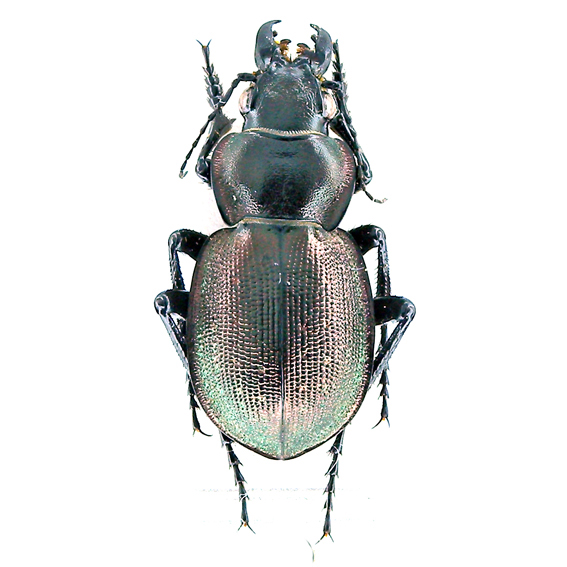 (Kirsh, 1859) (sub elegans kolshengelicum Obydov, 1997) S.E. Kazakhistan, S. Balkash lake, Kolshengel env., 28.IV.2000, S Toporov leg. |
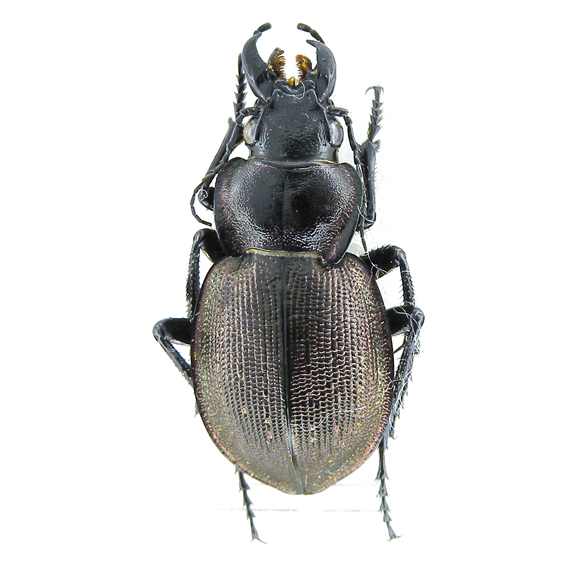 (Kirsh, 1859) (sub elegans kolshengelicum Obydov, 1997) S.E. Kazakhistan, S. Balkash lake, Kolshengel env., 28.IV.2000, S Toporov leg. |
 (Kirsh, 1859) S.E. Kazakhstan, 1.400m., Chu Yili mount., Kordai pass, 30.IV.2000 |
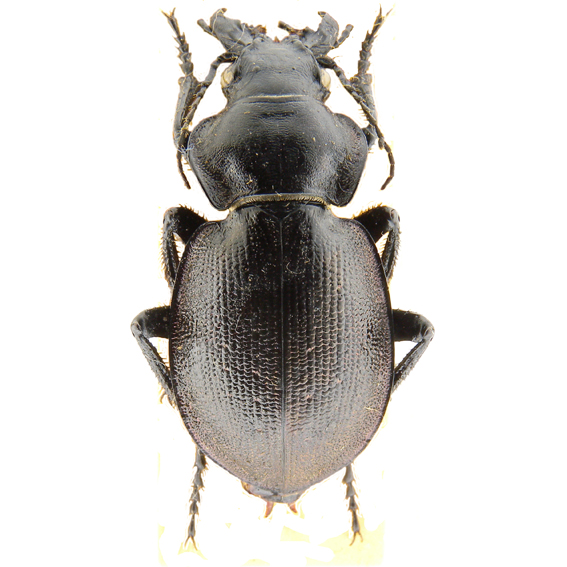 (Kirsh, 1859) Kazakhstan, Kordai 1.300m., 11.V.97, Danilevsky leg. |
 (Kirsh, 1859) (sub elegans valentinae Obydov, 1997) S.E. Kazakhstan, Ili river, Kapchagai env., 29.IV.2000 |
 (Kirsh, 1859) (sub elegans valentinae Obydov, 1997) S.E. Kazakhstan, Ili river, Kapchagai env., 29.IV.2000 |
 (Kirsh, 1859) (sub elegans saryarkensis Kabak, 1992) Kazakhistan, Shalgiya, 300m., 7.V.1996, M Danilevsky leg |
 (Kirsh, 1859) (sub elegans saryarkensis Kabak, 1992) Kazakhistan, Dzhezkazkgan reg., Shalgiia, 7.V.1996 |
Calosoma (Callisthenes) elegans manderstjernae (Ballion, 1870)
Callisthenes Manderstjernae Ballion, 1870: 323 (described from: Wernoje); unspecified number of specimens, repository not stated
Callisthenes karelini vernojensis Lapouge, 1924: 38 (described from: Wernyi); unspecified number of specimens in coll. Lapouge; lectotype ♀ designated by Deuve (1978: 255) in Muséum National d'Histoire Naturelle, Paris [examined]
Calosoma (Callisthenes) panderi ssp. elegans Breuning, 1928: 63 (partim)
Callisthenes karelini elegans manderstjernae Lapouge, 1932: 376
Callisthenes elegans manderstjernai Jeannel, 1940: 194
Callisthenes semenovi manderstjernae Obydov, 1997: 164
Callisthenes semenovi danilevskii Obydov, 1997: 165 (type locality: Kaskelen riv.); holotype ♂ ex coll. Obydov
Callisthenes elegans manderstjernae Obydov, 2002: 33
Callisthenes elegans keminensis Obydov, 2002: 36 (type locality: Kemin); holotype ♂ in coll. Danilevski
Callisthenes elegans danilevskii Obydov, 2002: 34
Length 25-35 mm. The first problem concerns the very definition of Callisthenes Manderstjernae. The type is in fact unavailable (Obidov, 1997: 164) and the description given by Ballion is short and unconclusive. Jeannel redescribed it as a subspecies of C. elegans and identified it with the large dark specimens, with olive or purple metallic reflections, having flat elytral sculpture tending to became of pentaploid model. Jeannel supposed these specimens living in the northern slope of the Zailijski Alatau mountains (Trans -Ili Alatau), from the surroundings of Almaty to the valley of the Charyn river. including amethystinus that he considered a simple chromatic variety.
Later Obidov (2002: 34) believed to recognize C. elegans manderstjernae in the specimens from Kastek pass and limited its distribution range to the western part of the Zailijski Alatau mountains. Previously he had described (Obydov 1997: 165) Callisthenes semenovi danilevskii, which in comparison with C. elegans manderstjernae, should be on average larger, slightly more slender, having a little more flattened elytral sculpture, of pentaploid model.
The characteristics indicated to distinguish the population called danilevskii are, the same as those indicated by Jeannel for manderstjernae. In reality, while there are many specimens of C. elegans manderstjiernae showing a beginning of doubling of the tertiary intervals and therefore a tendency towards a pentaploid model of sculpture, along most of the western Zailijski Alatau mountains, the splitting up line with respect to C. elegans elegans is difficult to identify. There, it is possible to find small populations with more noticeable intermediate characteristics, having more or less dark color and elytral sculpture flattened but again of triploid model. Sometimes the individuals of these populations are difficult to attribute to one or the other of the two subspecies.
However, taking into account their prevailing morphological characteristics, we prefer to treat the whole of of these populations in the context of C. elegans manderstjiernae. The same can be observed for other populations having similar characteristics and living on the south-western slopes of Zailijski Alatau mountains. One of them, characterized by flattened sculpture and dark color, was described as Callisthenes elegans keminensis, but in our opinion, as in the other cases we have talked about, it falls within the range of variability of C. elegans manderstjiernae.
In conclusion C. elegans manderstjernae can be described as constituted by medium to large size individuals with an elongated oval body, having an elytral sculpture which gradually tends to flatten. The intervals are visibly imbricated, the striae become confused and the model of elytral sculpture in extreme cases can become pentaploid, as the tertiary intervals tend to double. On the primary intervals there are shallow fovee hardly detectable because their bottom is of of the same color as the remaining surface of the elytra. The upper body is dark with faint cupric reflections.
C. elegans manderstjiernae, as previously defined, is located on the western slopes of the Zailijski Alatau mountain from Ulken Solutor and Kastek to the Kaskelen river valley and penetrates into Kyrgyzstan along the Kemin river valley.
Examined specimens and literature’s data
Kazakhstan. Žambyl reg: Kastek (SB), Ul’ken Sulutor (SB); Almaty reg. Wernyi (Almaty) (type of Callisthenes karelini vernojensis MNHN); Qarasaj distr: Kaskelen river valley, 1800m (SB) (Obidov, 1997: 165 sub sub elegans danilewskii)
Kyrgyzstan. Chuy reg.: Kemin (Bystrovka) 1300m. (SB) (Obydov, 2002: 36, sub elegans keminensis), Kizil-Bayrak 1450m (SB), Ak-Tuz (SB).
Notes: Brachypterous. It lives from 600 to 2300m. altitude. Adults were collected. in April – June, with small variations in relationship with the altitude of its habitat.
As regard to Callisthenes elegans danilevskii, Obydov (2002: 6) reports an interesting observation made by its discoverer. The specimens single or in pairs were found in holes dug into the ground down to 30cm deep. That is all the more interesting because, although adult specimens of other species of the subgenus have been observed sheltering in holes dug in the ground, in the other reported cases they remained close to the surface.
The species is named after General Alexander von Manderstjerna (1817-1888) a Russian entomologist. Sometime (Jeannel, 1940: 196) the species has been cited as manderstjernai that represents the more correct spelling, from a grammatical point of view, which should have been used (but that has not been used) in the original description.
 (Ballion, 1870) (sub elegans danilevskii Obydov, 1997) Kazakhstan, Almaty reg. Kaskalen gorge, 1650m. (43°05’22”N 76°35’14”E) 1-4.V.2015, Kovalenko lgt. |
 (Ballion, 1870) (sub elegans danilevskii Obydov, 1997) S.E. Kazakhstan, Zailijisky mount. rg., Kaskelen river 1800m, 15.V.2000, R Kadyrbekov leg |
 (Ballion, 1870) S.E. Kazakhstan, E Chu-Ili Mts, 10km NW Ulken Sulutor 1300m, (N43°19’43”, E75°07’02”),4.V.2011, Klimenko lgt. |
 (Ballion, 1870) S.E. Kazakhstan, E Chu-Ili Mts, 10km NW Ulken Sulutor 1300m, (N43°19’43”, E75°07’02”),4.V.2011, Klimenko leg |
 (Ballion, 1870) Kyrgyzstan. S slopes of Zailijisky mts. Ak-Tur v. 2000m., 24.V.1998 |
 (Ballion, 1870)) ( sub C. elegans keminensis Obydov 2002) Kyrgyzstan. Chuy reg. Trans-Ili Alatau mt. Range Chong-Kemin vall., Kyzil-Bairak 1450m., 11.V.2019 Toporov leg. |
 (Ballion, 1870) Kazakhstan. Almaty prov. val. riv. Kastek 1200-1350m. 6.V,2015 Rutjan lgt. |
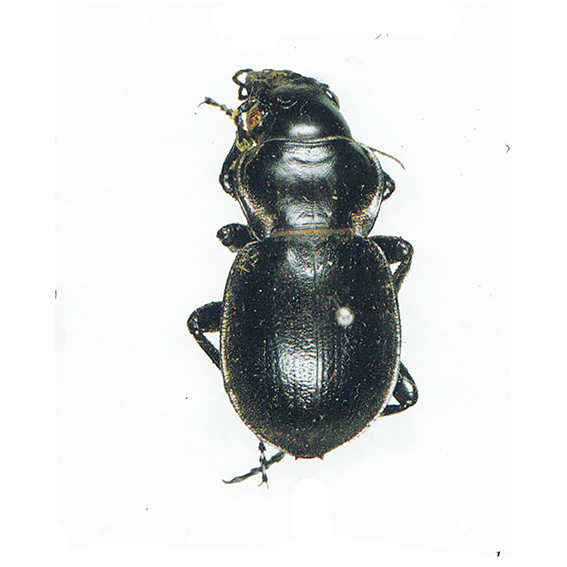 (Ballion, 1870) Wernyi (holotype of Callisthenes karelini vernojensis Lapouge, 1924) (coll. Muséum National d'Histoire Naturelle, Paris) |
Calosoma (Callisthenes) elegans semenovi (Motschulsky, 1859)
Callisthenes Semenovi Motschulsky, 1859: 128 (described from: Dzungarei Ala Tau) neotype ♂ designated by Kryzhanovskyi in Zoological Museum of the Zoological Institute of the Russian Academy of Sciences, Saint Petersburg (Obydov, 2002: 31)
Callisthenes Ssewertzowi Ballion, 1870: 323 (described from: Wernoje); unspecified number of specimens, repository not stated
Calosoma (Callisthenes) Ballioni Solsky, 1874: 24 (described from: Kokatau) 2 syntypes ♂ ♀ (from Chokand) designated by Obydov (2002: 31) in Zoological Museum of the Zoological Institute of the Russian Academy of Sciences, Saint Petersburg (Obydov, 2002: 32)
Callisthenes marginatus Ballioni Csiki, 1927: 27
Calosoma (Callisthenes) panderi var. elegans Breuning, 1928: 63 (partim)
Calosoma elegans ab. amethystinus Semenov-Tian-Shansky & Redikorzev, 1928: 111 (type locality: Charin riv.); holotype ♀ in Zoological Museum of the Zoological Institute of the Russian Academy of Sciences, Saint Petersburg (Obydov, 2002: 35)
Calosoma (Callisthenes) elegans semenovi Semenov, 1935: 273
Callisthenes karelini elegans semenowi Lapouge, 1932: 375
Callisthenes elegans semenovi Jeannel, 1940: 195
Callisthenes elegans manderstjernai var. amethystinus Jeannel, 1940: 196
Callisthenes semenovi Kryzhanovskij, 1962: 177
Callisthenes elegans ballioni Obydov, 1997: 164
Callisthenes elegans semenovi Obydov, 2002: 31
Callisthenes elegans amethystinus Obydov, 2002: 35
Calosoma (Callisthenes) elegans semenovi Bruschi, 2013: 258
Calosoma (Callisthenes) elegans amethystinum Kabak, 2022: 688
Length 18,5-34 mm. C. elegans semenovi, as we define it, occupies the souther central part of the Almaty region and is composed of a set of populations all characterized by the definitely flat elytral sculpture of triploid type with shallow imbrication, which in some cases is barely visible but anyway always identifiable. The body shape is short and rounded and the color of the upper body is variable from one population to another.
The populations living in the Almaty city area and neighboring districts are easily identifiable by the surface of the upper body alive with bright metallic luster and are those already recognized by Jeannel (1940: 195) as typical. To the south and south east of the city of Almaty you meet larger individuals (27-34 mm.), with barely visible foveae on the primary intervals and whose color of the upper body is a metallic green or greenish bronze (C. elegans semenovi, aut.).
The areas north of Almaty city are occupied by a population, that Obydov (1997: 164) considered as a distinct subspecies ( Callisthenes elegans ballioni). This population is only distinguishable by the slight smaller size (18.5-24 mm.), the more pronounced foveae on the primary intervals and by a less bright metallic copper color.
Still more towards north east (Eńbekšiqazaq district) there is another population that Obydov (2002: 35) regarded as one more subspecies (Callisthenes elegans amethystinus). This population, also of medium size (22-24 mm.), differs from the neighboring one (ballioni auct.) for the dark blue or violet color of the upper body.
In a precedent work (Bruschi, 2013: 258) we have considered all the populations, characterized by these varations of size and color. synonyms of C. elegans semenovi. However recently Kabak (2022: 688) reevaluated C. elegans amethystinus as a subspecies, based on the smaller size, the more distinct sculpture of the elytra, and on the color of the upper body blue or violet metallic.
Now, having examined series of specimens from various localities included in the distribution area of the supposed subspecies, we observed that the variations in size and elytral sculpture are very little relevant and that as for the color, there are intermediate chromatic forms with bronze, dark bronze, or dark green, metallic reflections. These intermediate forms are more common westwards (Ashohibulak area) while the blue green color predominates in the more eastern populations: slopes of the Turaigyr Range (Shelek area) and of the Karash Range (around Kokpek); with some exceptions where specimens having bronze or copper reflections on the margin of pronotum and elytra are still present (hunting preserve of Zhyngylsu, 10km N Kokpek).
Therefore, considering the poor morphological relevance of the variations and the presence of intermediate populations it seems preferable to avoid further distinctions and keep the whole described set within the variability of the subspecies we call C. elegans semenovi.
Examined specimens and literature’s data
Kazakhstan. Almaty reg. Almaty city env. (EM, SB); Bostandyk distr: Alma Arasan (SB); Ile distr: Boralday (SB); Karasai Distr: Aksai river (SB); Talgar. distr: Talgar env. 2000m, (SB), Eltai village env. (SB), Isaevo vill. 700m. (SB); Eńbekšiqazaq distr: Ashohibulak (SB) , near Chilik (Shelek) and Chilik river valley (SB), around Kokpek (SB), hunting preserve of Zhyngylsu (10km N Kokpek) (SB), Malybay (Obydov, 2002: 36 sub elegans amethystinus).
Notes: Brachypterous. It has been found in the plain and hills, at around 550m altitude up to 1000-1200m in the foothills of the mountain. Adults were collected from April up to July.
The taxon has been named after Pyotr Petrovich Semenov-Tian-Shansky (1827 – 1914) a Russian geographer and statistician who managed the Russian Geographical Society for more than 40 years. In the years 1856/57 he explored the mountains of the Tian Shan of which he published the first systematic description. The reputation of this monograph was such that half a century later Nicholas II of Russia authorized him to add the epithet "Tian-Shansky" to his last name. His son Andrey Petrovich Semenov-Tian-Shansky (1866–1942) became, in his turn, an important entomologist and described many taxa of the genus Calosoma.
 (Motschulsky, 1859) South Kasachistan, Alma ata distr., 15.5.78 |
 (Motschulsky, 1859) South Kasachistan, Alma ata distr., 15.5.78 |
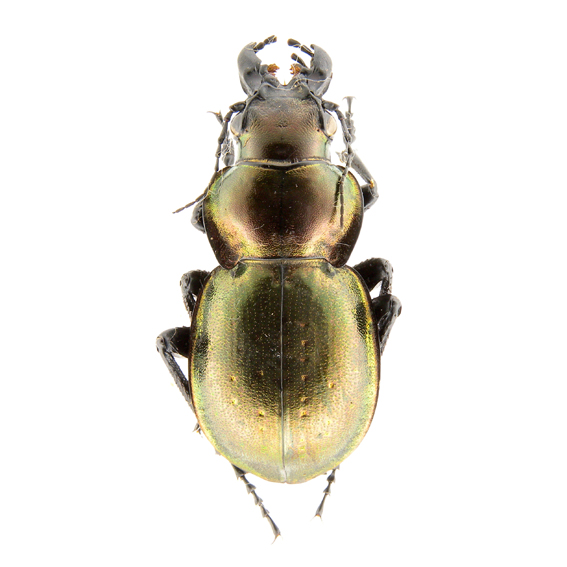 (Motschulsky, 1859) (sub elegans ballioni Solsky, 1874) S. Kazakhstan, Zailijisky mount. rg., Aksai river, 10.V.2000, Kadyberkov |
 (Motschulsky, 1859) (sub elegans ballioni Solsky, 1874) S. Kazakhstan, Zailijisky mount. rg., Aksai river, 10.V.2000, Kadyberkov |
 (Motschulsky, 1859) (sub elegans amethystinus Semenov-Tian-Shansky & Redikorzev, 1928) Almaty reg. Ashohibulak vill., 1200m. (43°27’41”N 77°47’49”E) 16-17.IV.2017, Kovalenko lgt. |
 (Motschulsky, 1859) (sub elegans amethystinus Semenov-Tian-Shansky & Redikorzev, 1928) Almaty reg. Ashohibulak vill., 1200m. (43°27’41”N 77°47’49”E) 16-17.IV.2017, Kovalenko lgt. |
 (Motschulsky, 1859) (sub elegans amethystinus Semenov-Tian-Shansky & Redikorzev, 1928) Almaty reg. Ashohibulak vill., 1200m. (43°27’41”N 77°47’49”E) 16-17.IV.2017, Kovalenko lgt. |
 (Motschulsky, 1859) (sub elegans amethystinus Semenov-Tian-Shansky & Redikorzev, 1928) Boguty mts. 900m. (43°33’53”N 78°38’16”E), 10.IV.2019 (hunting preserve of Zhyngylsu, 10km N Kokpek) |
 (Motschulsky, 1859) (sub elegans amethystinus Semenov-Tian-Shansky & Redikorzev, 1928) S.E. Kazakhstan, Zailijisky mount. range, Chilik vill. (Shelek), 800m., 5.V.2000 |
 (Motschulsky, 1859) (sub elegans amethystinus Semenov-Tian-Shansky & Redikorzev, 1928) S.E. Kazakhistan, Zailijisky mount. range, Sugety valley, Kokpek env., 2.V.1999, Neforosnyi lgt., |
Calosoma (Callisthenes) elegans rostislavi Semenov, 1906
Calosoma rostislavi Semenov, 1906: 262 (described from: vallis fluminis Ili haud procul ab. opp. Dzharkent); holotype ♂ (ex coll. Semenov) in Zoological Museum of the Russian Academy of Sciences, Saint Petersburg (Obydov, 2002: 18)
Calosoma (Callisthenes) panderi ssp. elegans var. declive Breuning, 1928: 65 (partim)
Callisthenes elegans declivis Jeannel, 1940: 195 (partim)
Calosoma (Callisthenes) subtilestriatum Mandl, 1954: 163 (type locality: Kuldsha); holotype ♂ and 1 paratype ♂ in Naturhistorischen Museum, Wien
Callisthenes karelini rostislavi Kryzhanovskij & al. 1995: 34
Callisthenes declivis Obydov, 1997: 168 (partim)
Callisthenes subtilestriatus Obydov, 1997: 169
Calosoma (Callisthenes) rostislavi Kabak, 2016: 798
Calosoma (Callisthenes) elegans rostislavi Kabak, 2022: 688
Calosoma (Callisthenes) elegans kashense Kabak, 2022: 692 (type locality: Xinjiang, E of Nilki Town) holotype ♂ in Zoological Museum of the Russian Academy of Sciences, Saint Petersburg, paratypes 4 ♂, 1 ♀ in collection of I.A. Belousov and I.I. Kabak (St. Petersburg)
Calosoma (Callisthenes) elegans gongliuense Kabak & Liang, 2023: 320 (type locality: Xinjiang, Gongliu County, Wutu vill.) holotype ♂ paratype ♀ in collection of Chinese Academy of Science, Beijing
Length 17-21 mm. Basing on the original description (Dohrn, 1884: 405) , C. declivis has been longtime errounously identified with the population of the Ili river that Semenov (1906: 262) later described as C. rostislavi.
Both Breuning (1928: 76) and Jeannel (1940: 195) have regarded it as a population inside C. elegans, of which rostislavi became a synonym, but Obidov (1997: 168) placed this population at the species level in the panderi-karelini group, followed by most of the later authors. However, recently Kabak (2016), having definitively established the sinonimy of C. declivis with C. elegans elegans, restored the name C. rostislavi as a distinct species.
Kabak then continued to study the issue (Kabak, 2022 and Kabak & Liang, 2023) and, based on in-depth researches, defined the distribution range ofC. elegans rostislavi more precisely within the Chinese border (Ili Kazakh Autonomous Prefecture along the river of the same name). With the occasions he proposed two more subspecies:C. elegans kashense and C. elegans gongliuense. Both were found on the left bank of the Ili River and both are characterized by the more pronounced coppery sheen of the surfaces of the upper body and have small differences in the shape of the pronotum and elytra.
C. elegans kashense is characterized mainly by the more elongated elytra and by the visibly more developed sculpture of the elytra. C. elegans gongliuense, which represents the easternmost population of C. elegans known at the moment, has a relatively stockier shape, and is easily recognizable by the vibrant bronze metallic luster on the edges of the upper body that may extend to the entire surface.
There remains the problem of subtilestriatum which was described by Mandl (1954: 163) as distinct species. It has been considered as synonim of Callisthenes karelini rostislavi by Kryzhanovskij et alia (1995: 34) and again as distinct species by Obydov (1997: 169), but we (Bruschi, 2013 ) have treated it as a subspecies of C. elegans, very close from a phylogenetic point of view to C. elegans rostislavi.
Subsequently Kabak (2022: 691) would have recognized the characteristics of subtilestriatum in some specimens which he attributed to C. elegans rostislavi and thus formally established its synonymy.
The specimens originally attributed to C. elegans subtilestriatum are characterized by the rought surface of its broad pronotum and by the short elytra with the upper surface noticeably arched and steep, sharply sloping in the apical part. The elytral sculpture is of triploid type with moderately raise and incised intervals. The intervals are separated by deep puncturated striae and the primary dimples are hardly discernible. The color of the upper part od the body is dark with cupric reflections.
Considering these characters, subtilestriatum is slightly distinct from any other populations, identified by Kabak, including the two new subspecies, even if all of them shares many common features. However it is necessary to consider that the variations in body proportions and coloration, exhaustively highlighted by Kabak, that characterize each of them are very small. Consequently subtilestriatum as well as the two proposed subspecies could fall within the set of populations, just slightly diversified from each other, that together constitute the rostislavi as subspecies of elegans. For this reason, at least for the moment, we do not believe it is justified to further subdivide it.
C. elegans rostislavi, in our sense, has relatively voluminous head and a broad wrinkled pronotum with elevated lateral margin, The elytra are oval in shape and more or less elongated and with a showy sloping in the apical part. The elytral sculpture is characterized by a regular scheme of triploid type, with flat or slightly raised intervals separated by fine puncturated striae, the primary dimples being almost indistinguishable. The surface of the upper body is dark with metallic reflections on the borders or, rarely, on the entire surface.
This subspecies is found on both the banks of the initial trait of the Ili rive, in Kazakhstan and inside the Chinese border (Ili Kazakh Autonomous Prefecture).
Examined specimens and literature’s data
China. Xinjiang. Ili Kazakh Autonomous Prefecture: mountains north of Kuldja (Yining) (Breuning, 1928: 65, sub elegans declive); Yili (Ili) river (SB), Tianshan mts. (SB); Huocheng County (www.inaturalist.org); Yining (Kuldscha, Gulja) county (SB); Piluchi (30km. N of Yining) (Kabak, 2022: 689); E of Karagatsh Vill (45 km. N of Yining) (Kabak, 2022: 689); Gongliu County: 50 km SE of Yining (Kabak, 2022: 689); southwards of the city of Gongliu (sub. elegans gongliuense; Kabak & Liang, 2023: 320); Nilka county, E. of Nilka Town (sub elegans kashense; Kabak, 2022: 692); Kuldscha (Mandl, 1954: 163, type of C: subtilestriatum); Monts Boro-Khoro, 50km East of Kuldzha, env. de Nilka (Obydov, 2002: 38, subC: subtilestriatum);
Kazakhstan. Zhetisu reg. Panfilov distr: Ili river near Dharkent (Zharkent) (Semenov loc. typ.), Sarymbel env. (Kabak, 2022: 689); Almaty reg. Ūjǧyr distr: Ketmen mts (Kabak, 2022: 689), Dubun vill. (Kabak, 2022: 689).
Notes: Brachypterous. C. elegans rostislavi lives in sands and ephemeral landscapes at medium altitude, from 600 to 1400m (Kabak, 2022: 694). Adults were mainly collected from March to May but, judging from the material examined, it seems that it will still be possible to find it until June-July.
The name intends to remember the brother of the author.
 Semenov, 1906 China, Xinjiang, Manaogou Yili (Yining), III.2020 |
 Semenov, 1906 China, Xinjiang, Yining, VI.2020 |
 (holotype of Callisthenes subtilestriatum Mandl, 1954) Kuldsha; Naturhistorischen Museum, Wien (photo Obidov, http://www.zin.ru) |
 (sub Calosoma (Callisthenes) elegans subtilestriatum Mandl, 1954) Kuldja , Mont Bor., (Yining env. Borohoro Mts.) (coll Bruschi, ex coll. Gottwald) |
Calosoma (Callisthenes) elegans karagaicum (Lapouge, 1924)
Callisthenes Karelini karagaicus Lapouge, 1924: 37 (described from: Karagai Tau) original material: unspecified number of specimens, repository not stated, possible syntypes in MNHN according to Jeannel (1940: 194) but not to be found (Deuve, 1978: 255)
Calosoma (Callisthenes) panderi ssp. elegans var. karagaicum Breuning, 1928: 61
Callisthenes karelini elegans karagaicus Lapouge, 1932: 376
Callisthenes elegans declivis Jeannel, 1940: 195 (partim)
Callisthenes karagaicus Obydov, 1997: 169
Length 18-22,5 mm. C. elegans karagaicum is chiefly characterized by the almost completely flat elytral sculpture, where the primary intervals are easily identifiable by the bronze or green metallic foveae. It is possible to recognize series of clearly visible points which separate three intervals between the primary ones (triploid model of elytral sculpture), but it may happen that in the specimens where the intervals, even flat, are more strongly tegulated, the tertiary ones are confusely doubled.
The color of the upper part of the body is dark brown, or black, with a faint cupric reflection which in some cases can be more easily noticed on the edges of the pronotum and on the shower of the elytra.
At first sight C. elegans karagaicum is not easily distinguishable from other populations of C. elegans that have a flattened sculpture, and dark color, almost black, of the upper body, in in first place from C. elegans manderstjernae. However it can be identified with a careful examination as the lateral borders of the pronotum are large but less raised and the posterior lobes are less developed than in any other populations, and add that the foveae, corresponding to the primary intervals, are always clearly visible, large and with green cupric bottom.
C. elegans karagaicum that gathers together the southernmost populations of the cluster of C. elegans, and that Obidov considers in itself a separate species, is limited to the inner Tien Shan in Kyrgyzstan, and so it is relatively isolated from other populations.
Examined specimens and literature’s data
Kyrgyzstan. Naryn reg: Naryn. (SB), Semir jetschensk (SB), 20km N. Naryn town, (SB), environ de Narine (EM, SB), Narynsk (SB), At-Bashi (Obydov, 2002: 38); Jalal-Abad reg: Kugart (Obydov, 2002: 38)
Notes: Brachypterous. It lives around 1200-1800m. altitude. Adults were collected. from May to July.
 (Lapouge, 1924) Kirghizstan: Tian Shan, 20km N. Naryn town, 27.V.1998 |
 (Lapouge, 1924) Kirghizstan: Tian Shan, 20km N. Naryn town, 27.V.1998 |
updated April 18 2024